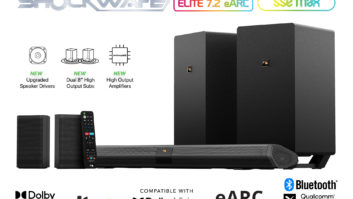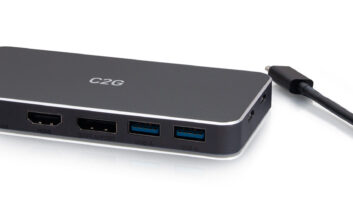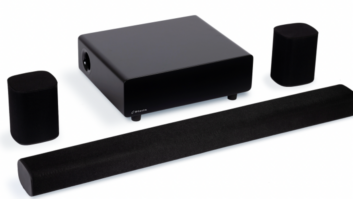In my last column, I talked about the history of multi-channel sound in the home, including Surround EX, DTS-ES, and various listening modes that expand 5.1 channels to seven speakers and a subwoofer. None of those were really 7.1, though, and the 7.1-ready systems that youve installed to date may not be as ready as you think. Heres what you can do to ensure that your clients are getting the full 7.1 experience.
7.1: Home vs. Cinema Mixes
Movie soundtracks are originally mixed for commercial cinema release. The rooms used to prepare these mixes are very comparable to an average cinema in terms of size, equipment, and layout. From its inception, home video received the same soundtracks that were mixed for the cinema, which resulted in some rather audible large/small room translation issues. As the DVD format matured, a few studios begin engineering special home video mixes that attempted to compensate for the most prominent sonic inconsistencies. While their efforts were not always successful, the studios were at least trying.
Why does this have any bearing on 7.1? Well, the 7.1 format with its three fronts, two sides, two rears, and LFE doesnt exist in the cinema world. (They technically do have 7.1, but, ironically enough, its a little-used format with five fronts, two sides, and an LFE; no rears.) The mixes prepared by a movies original sound team for commercial release dont have two rear channels. The overwhelming majority doesnt even have one rear channel; Surround EX hasnt been terribly popular (not that it was ever intended for widespread use). Where 7.1 enters the picture is during aftermarket remixing of soundtracks for home video.
In addition to being tweaked to sound better in small rooms, cinema mixes may also be expanded from 5.1 to 7.1 channels. Typically, this involves unwrapping the 5.1 dialog, music, and effects stems (the building blocks of a soundtrack), adjusting the pan of certain effects in the surround field, and mixing the new 7.1 stems down into a final track. I wont go into the minute details of the process, because you are custom integrators not sound mixers. Suffice it to say that the resulting remixes are, indeed, 7.1 discrete channels, even though they werent created that way by the original sound team. Thanks to Blu-ray and HD DVD, studios can provide these 7.1 home video mixes in uncompressed form, or with lossless and high-quality lossy compression from Dolby and DTS.
From the Disc to the Speakers
There may be 7.1 channels on the disc, but they wont do you much good unless you can get them to the speakers. Most problems with 7.1 occur between the player and the A/V controller, and this is where systems that you have installed in the past will probably require the most attention. As of this writing, there are three common ways to get the signal from the player to the controller.
The number-one way is to connect the player to the controller with HDMI and transfer the audio as PCM. This method is popular because it is currently the only way to hear menu-based sound effects (button clicks and cursor swooshes) and secondary audio that plays alongside the feature (director, etc., appears in a PiP window and talks while the movie plays). Another reason for its popularity is the short supply of controllers that decode the new Dolby and DTS formats.
Players are far more likely to have the appropriate decoders, and therein lies the problem with way number one. Players may decode some of the new formats, but usually not all… or at least not for 7.1 channels. If you plan to have the player handle decoding, be sure it supports Dolby Digital Plus, Dolby TrueHD, DTS-HD High Resolution, and DTS-HD Master Audio all the way up to 7.1. You also need to make sure the controller will accept up to 7.1 channels of PCM and still engage listening modes like Dolby ProLogic IIx and THX Ultra2 when necessary. (A few controllers will not apply listening modes to PCM.) Finally, something must do speaker distances, channel levels, and bass management (including the +10dB LFE gain boost). Not all players will, and neither will all controllers when the input format is PCM. Be sure yours do.
The second way to get the signal from the player to the controller is similar to way number one, except the player is connected to the AV controller with eight analog cables (7.1 analog) instead of HDMI. The player still decodes the audio, but also converts it to analog. For the most part, the advice from above applies here, too. Be sure the player decodes up to 7.1 channels, be sure it has a 7.1 analog output, be sure the controller has a 7.1 input, and be sure either the player or controller adjusts speaker distances, channel levels, and bass management. With 7.1 analog, you also have to watch the gain of the players subwoofer output. It can legitimately be up to 15dB low, requiring a boost that not all controllers supply.
The third way to get the signal from the player to the controller is to connect the player to the AV controller with HDMI 1.3 and transfer the audio as bitstream (non-decoded). Obviously, this requires the controller to decode all of the latest audio formats up to 7.1 channels, which it will probably do if it has HDMI 1.3 inputs. Keep in mind, though, that menu-based sound effects and secondary audio will be lost. Beyond that, theres not too much to worry about. Just do what youve done in the past with controllers that decode legacy Dolby Digital and DTS.
Where, O Where, Do My Speakers Go?
Admittedly, getting the signal from the disc to the speakers is only part of the picture. The speakers have to be positioned correctly in the room, or else you will never hear what the mixer intended for his soundtrack.
By and large, the people who are remixing tracks for home video have adopted monitoring systems that are laid out much like the typical home theater. The side speakers are +/-90-110 degrees, and the rear speakers are +/-135-150 degrees. (If you are unfamiliar with this terminology, imagine that you are sitting in the primary seat in the middle of the room. The center speaker is 0 degrees and directly behind you is 180 degrees.) As far as the height of the speakers in the room is concerned, six feet up from the floor is always a safe bet. The monitors in a studio may be a little lower than that, but the extra height will add more of a cinematic feel and substantially improve coverage for multi-seat rooms.
The good news is that the surround speakers in your systems are probably already in those positions, or close to it. They are the same ones that groups like Dolby and THX were recommending as far back as the introduction of Surround EX to the consumer market in 2000.
And, of course, the debate over whether to use dipole or direct speakers rages on. At the risk of blowing my allotted space, I will leave you with this parting thought. The answer to the dipole vs. direct question may lie in the type of room you have. Dipoles are probably going to work better in small, well-damped rooms, while directs may be the way to go in larger or more reverberant spaces. The goal is for the surround speakers themselves to disappear into the sound field: ambient effects should be spacious, and discrete effects should be localizable, but not necessarily to a specific speaker. The decision of whether dipoles or directs achieve this goal in a given application is ultimately yours, so feel free to experiment.
Chase Walton contributed to this article.







